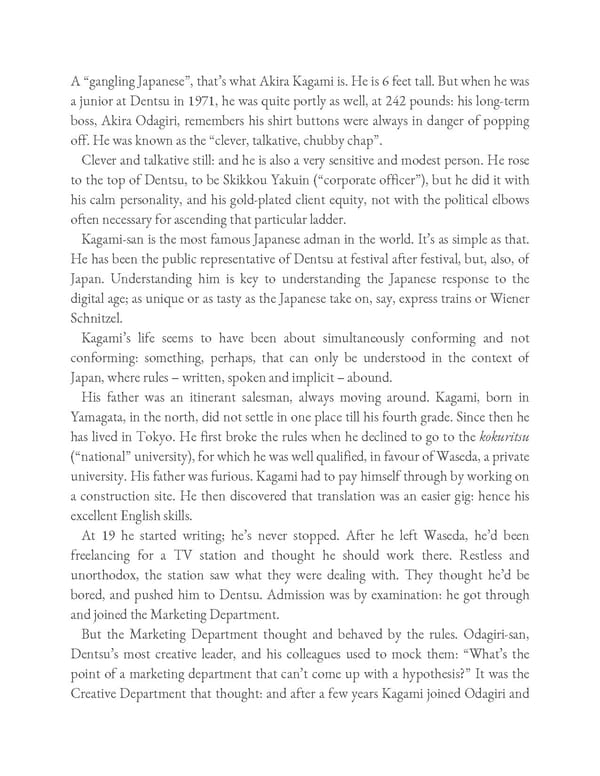A “gangling Japanese”, that’s what Akira Kagami is. He is 6 feet tall. But when he was a junior at Dentsu in 1971, he was quite portly as well, at 242 pounds: his long-term boss, Akira Odagiri, remembers his shirt buttons were always in danger of popping off. He was known as the “clever, talkative, chubby chap”. Clever and talkative still: and he is also a very sensitive and modest person. He rose to the top of Dentsu, to be Skikkou Yakuin (“corporate officer”), but he did it with his calm personality, and his gold-plated client equity, not with the political elbows often necessary for ascending that particular ladder. Kagami-san is the most famous Japanese adman in the world. It’s as simple as that. He has been the public representative of Dentsu at festival after festival, but, also, of Japan. Understanding him is key to understanding the Japanese response to the digital age; as unique or as tasty as the Japanese take on, say, express trains or Wiener Schnitzel. Kagami’s life seems to have been about simultaneously conforming and not conforming: something, perhaps, that can only be understood in the context of Japan, where rules – written, spoken and implicit – abound. His father was an itinerant salesman, always moving around. Kagami, born in Yamagata, in the north, did not settle in one place till his fourth grade. Since then he has lived in Tokyo. He first broke the rules when he declined to go to the kokuritsu (“national” university), for which he was well qualified, in favour of Waseda, a private university. His father was furious. Kagami had to pay himself through by working on a construction site. He then discovered that translation was an easier gig: hence his excellent English skills. At 19 he started writing; he’s never stopped. After he left Waseda, he’d been freelancing for a TV station and thought he should work there. Restless and unorthodox, the station saw what they were dealing with. They thought he’d be bored, and pushed him to Dentsu. Admission was by examination: he got through and joined the Marketing Department. But the Marketing Department thought and behaved by the rules. Odagiri-san, Dentsu’s most creative leader, and his colleagues used to mock them: “What’s the point of a marketing department that can’t come up with a hypothesis?” It was the Creative Department that thought: and after a few years Kagami joined Odagiri and
 Ogilvy on Advertising in the Digital Age Page 366 Page 368
Ogilvy on Advertising in the Digital Age Page 366 Page 368